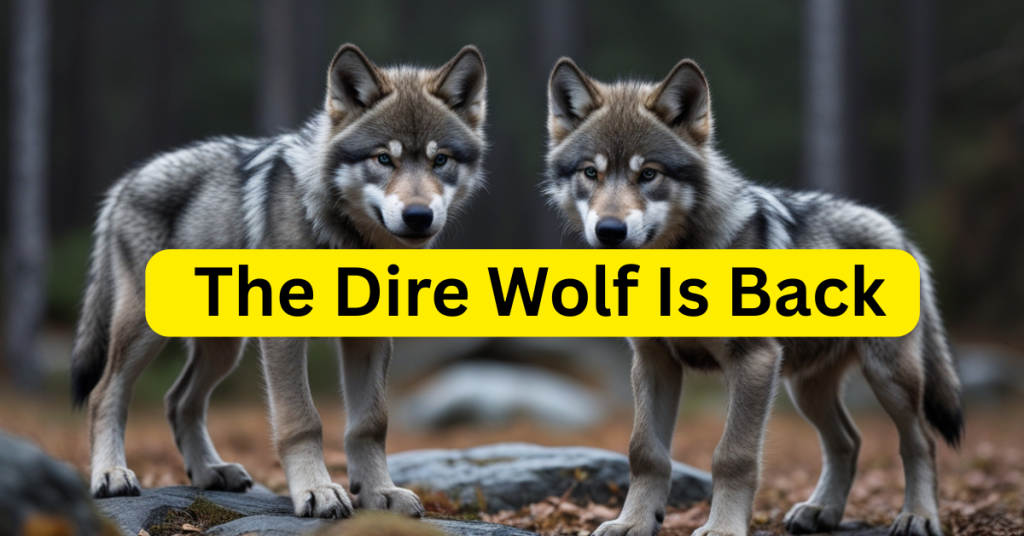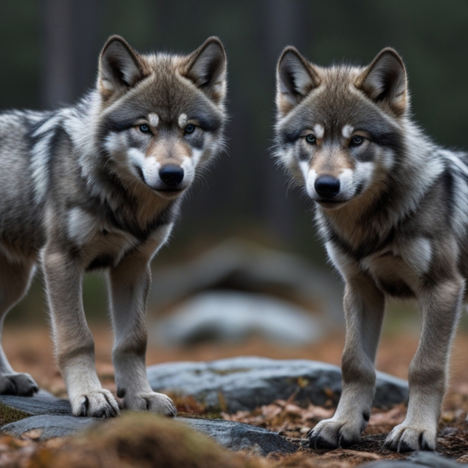Key Points

- Research suggests Colossal Biosciences has created genetically modified wolf pups with dire wolf traits, but controversy exists over whether they are true dire wolves.
- The process involved CRISPR technology and ancient DNA, with pups born in October 2024 and January 2025.
- It seems likely that this achievement is a step toward de-extinction, though scientists debate its classification and ethical implications.
Background
Colossal Biosciences, a Texas-based biotech firm, announced in early April 2025 that it had brought back the dire wolf, an animal extinct for over 10,000 years, through de-extinction technology. This news has generated significant interest, but also skepticism, as the pups are genetically modified grey wolves with dire wolf traits, not exact replicas of the extinct species.
The Process
The company used CRISPR to edit the genomes of grey wolf cells, incorporating 20 genetic differences from ancient dire wolf DNA extracted from fossils up to 72,000 years old. These edited cells were implanted into surrogate dogs, resulting in the birth of three pups: Romulus and Remus (born October 1, 2024) and Khaleesi (born January 30, 2025). The pups, currently housed in a secure 2,000-acre preserve, exhibit traits like larger size and white coats, but are 99.9% grey wolf DNA.
Controversy and Implications
While Colossal claims this as the world’s first de-extinction, many scientists argue the pups are not true dire wolves, raising questions about the definition of de-extinction. Ethical debates focus on whether resources should prioritize conserving existing species over resurrecting extinct ones, with some seeing potential for ecosystem restoration and others viewing it as a distraction.
Detailed Analysis and Observations
The recent announcement by Colossal Biosciences regarding the purported return of the dire wolf through de-extinction technology has sparked widespread interest and debate, particularly given its timing in early April 2025. This development, while groundbreaking, is mired in scientific, ethical, and public discourse, offering a complex case study in the evolving field of genetic engineering. Below, we explore the details, implications, and reactions surrounding this event, aiming to provide a comprehensive overview for readers interested in the intersection of science, conservation, and ethics.
Context and Initial Announcement
On April 7, 2025, Colossal Biosciences, a Texas-based biotech firm valued at $10.2 billion with $435 million in committed investment, declared the successful de-extinction of the dire wolf, an animal extinct for over 10,000 years and famously depicted in popular culture like Game of Thrones. The company introduced three pups—Romulus, Remus, and Khaleesi—as the “world’s first de-extinct animals,” born through a process involving genetic engineering and surrogate motherhood. This announcement was covered extensively by major outlets such as The New Yorker, Al Jazeera, and CNN, reflecting its global significance.
Public reaction, as seen on X, was mixed. Enthusiastic posts like one from @stillgray on April 7, 2025, described it as “AWESOME,” while @colossal shared a video of the pups’ first howl, captioned, “You’re hearing the first howl of a dire wolf in over 10,000 years” (X post). Conversely, skepticism was evident, with @newscientist posting on April 8, 2025, “De-extinction company Colossal Biosciences claims to have brought back the dire wolf – it hasn’t” (X post), highlighting the controversy.
Scientific Process and Methodology
The de-extinction process began in summer 2023, involving the extraction of ancient DNA from dire wolf fossils, including a 13,000-year-old tooth from Sheriden Cave, Ohio, and a 72,000-year-old skull from American Falls Reservoir, Idaho, as detailed in The New Yorker. Researchers reconstructed 91% of the dire wolf genome, leveraging the fact that the grey wolf, sharing 99.5% DNA with the dire wolf (Nature), served as the closest living relative.
Using CRISPR, a gene-editing tool, scientists made 20 edits across 14 genes, incorporating 15 dire wolf and 5 grey wolf genetic variants to introduce traits like larger size, broader heads, and thicker fur. This edited genetic material was inserted into egg cells from domestic dogs, and 45 embryos were implanted into two surrogate mixed-breed dogs. Only two embryos grew to term, resulting in the birth of three pups on October 1, 2024, via Cesarean section, with one pup notably twice the weight of a typical grey wolf at birth. By March 25, 2025, the pups were five months old, each weighing around 80 pounds and projected to reach 140 pounds at maturity, as reported by Al Jazeera.
The pups, named Romulus, Remus, and Khaleesi, are housed in a secure 2,000-acre preserve protected by a 10-foot-high fence and monitored by drones, with no plans for breeding, aiming instead for 3-5 more genetically engineered animals in the future.
Scientific Debate and Classification
Despite Colossal’s claims, the scientific community is divided. The company describes the pups as de-extinct dire wolves, with Love Dalén, an evolutionary genomics professor at Stockholm University and Colossal adviser, stating, “There’s no secret that across the genome, this is 99.9 percent grey wolf… carries dire wolf genes, makes it look more like a dire wolf than anything we’ve seen in the last 13,000 years. And that is very cool” (Al Jazeera). However, critics like Dan Ashe, president and CEO of the Association of Zoos and Aquariums, argue, “We can’t protect what we already have,” emphasizing that these are genetically modified grey wolves, not true dire wolves (Al Jazeera).
New Scientist and BBC echoed this skepticism, with articles published on April 8, 2025, stating the pups are not dire wolves but modified grey wolves. This debate centers on the definition of de-extinction, with some arguing true de-extinction requires a complete genome reconstruction, which was not achieved here, as only 91% was reconstructed.
Ethical and Conservation Implications
The ethical implications are profound. Critics, including Ashe, argue that the $435 million invested in Colossal could be better spent on conserving existing endangered species, given the alarming rate of extinction—up to 55,000 species per year, with 1 million threatened per UN estimates, as noted on Colossal’s website. Conversely, Colossal sees de-extinction as a conservation tool, with Andrew Pask, an advisory board member, stating, “This project demonstrates the awesome potential for advances in genetic engineering and reproductive technologies to recreate lost diversity… stabilise ecosystems to prevent further biodiversity losses and to create new methods to actually restore lost biodiversity” (Al Jazeera).
The welfare of these genetically modified animals is also a concern, as they exhibit both dog-like and wolf-like behaviors, not exact replicas of their extinct counterparts, potentially unable to fulfill ecological roles. The Hindu on April 18, 2025, framed the first dire wolf howl in 10,000 years as “less of a triumphant echo from the past and more of a warning to the present, urging us to rethink the path we are on.”
Public and Media Reaction
Media coverage has been extensive, with The New York Times and Ars Technica reporting on April 7-8, 2025, while X posts reflected a polarized public. Enthusiastic users like @gunsnrosesgirl3 on April 8, 2025, shared, “You’re hearing the first howl of a dire wolf in over 10,000 years” (X post), while @ScienceMagazine on April 10, 2025, noted, “The bold claim was immediately met with skepticism and outrage from scientists on social media” (X post).
Future Directions and Broader Impact
Colossal’s ambitions extend beyond the dire wolf, with plans to de-extinct the woolly mammoth, as seen on their website (Colossal). This project is viewed as a proof-of-concept, potentially revolutionizing conservation by restoring lost species to ecosystems. However, challenges remain, including ensuring these animals can thrive and the ethical considerations of creating genetically modified organisms for ecological roles they may not fully fulfill.
In conclusion, the dire wolf de-extinction by Colossal Biosciences is a landmark in genetic engineering, highlighting both the potential and pitfalls of de-extinction. As of May 17, 2025, it remains a topic of active debate, with significant implications for science, conservation, and our relationship with nature.
Detailed Data Table
Below is a summary of key details from the dire wolf de-extinction project, as gathered from various sources:
| Aspect | Details |
|---|---|
| Company | Colossal Biosciences |
| Project Start Date | Summer 2023 |
| Pups Born | Romulus, Remus (Oct 1, 2024), Khaleesi (Jan 30, 2025) |
| DNA Source | 13,000-year-old tooth (Ohio), 72,000-year-old skull (Idaho) |
| Genome Reconstruction | 91% of dire wolf genome established |
| Genetic Edits | 20 edits on 14 genes (15 dire wolf, 5 grey wolf) |
| Surrogate Mothers | Two mixed-breed dogs (e.g., hound mix) |
| Embryos Implanted | 45 embryos, 2 grew to term |
| Current Age and Weight (March 25) | 5 months old, ~80 pounds each, expected to reach ~140 pounds at maturity |
| Habitat | 2,000-acre preserve, 10-foot-high fence, drone surveillance |
| Breeding Plans | No breeding allowed, plans for 3-5 more genetically engineered animals |
| Investment | $435m committed, valuation boosted to $10.2bn |









Leave a Reply